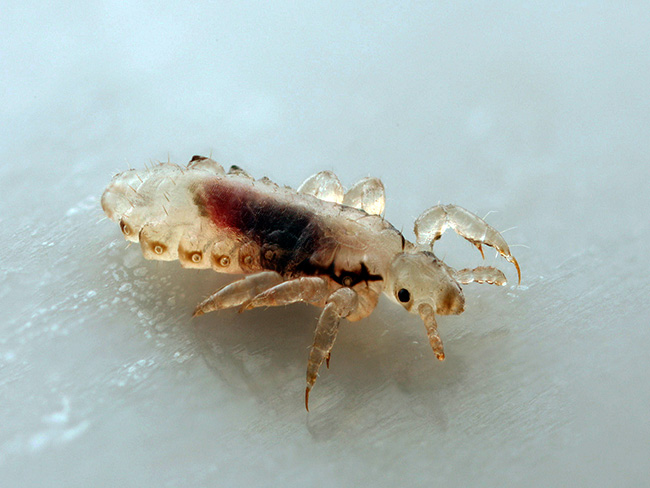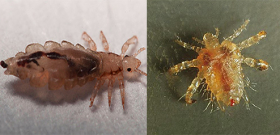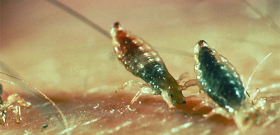
It is well known that lice appear in a person for one single reason - they fall on him from another person, multiply over time and become noticeable, creating many problems.
As soon as most people learn about the causes of head lice, they immediately stumble over a seeming paradox: if lice are taken from a person only from another person, then how and from whom did the very first infection in history occur? And could it happen at all?
Junior Research Fellow, Department of Zoology, ONU named after Mechnikov Boris Sagaydachny analyzed this paradox in detail for our readers and showed that, in fact, there is no paradox, but the very question of the first infection in history is not entirely correct. Let's figure it out...
How did lice first appear in humans? It is the very first lice in the very first people!
The fact is that lice did not appear in humans. Lice have originally parasitized humans throughout human history as a species. They lived on ancient monkeys - the ancestors of people, parasitized on ancient people, then on all types of ancient people, including Denisovans, Neanderthals and Cro-Magnons, and then on modern people.
In other words, there was no such moment in history until which lice would not bite people, and then suddenly they took on people for some reason and began to parasitize on them.It can be said in another way: lice appeared on a person when the person himself ceased to be a monkey, and became a man.
There is no clear boundary between ancient people and great apes. We do not know, and most likely will never in the future agree on a specific moment in history before which only great apes existed, and after which real people already appeared. Evolution does not work like that: there are always thousands of generations that cannot be unequivocally attributed to either apes or humans. And lice lived on these "indefinite" primates, and on their ancestors - monkeys, and on already unambiguous people.

In fact, the ancient ancestors of lice did not infect humans, but monkeys and earlier ancestors of the monkeys themselves, and then simply passed on.
But if lice are transferred from one individual to another, then how did they infect the very first monkeys? How did they eat and live before that, and why did they “switch”?
Lice evolved and “passed over” to the ancient monkeys and their ancestors as gradually as the monkeys themselves, along with the lice in wool, turned into people.
According to the dominant point of view today, the ancestors of blood-sucking lice were the so-called gnawing lice, which did not pierce the host's skin to suck blood, but gnawed it and licked the blood. The main difference between sucking and chewing lice lies in the structure of the mouth apparatus.
Gnawing hematophagous lice, feeding mainly on blood, in turn descended from hay eaters, who initially fed on various integuments of the body of their hosts - hair, feathers, down - and their skin secretions.And these hay-eaters could already have descended from forms that lead the same lifestyle as modern book and dust lice lead - live in places of accumulation of dying organic matter and gnaw everything that is possible: grass and hay, lichens, mold, skin peeling off animals and shedding feathers.
In other words, the history of the appearance of lice in nature can be described as follows: the ancient hay-eaters started and multiplied in the nests of birds, or burrows and dens of mammals - the ancestors of primates. Here they initially fed on nesting material (grass, leaves), feathers, down and wool. Over time, some of them adapted to stay in the fur of animals in order to protect themselves from losing their food source - if, for example, the host animal leaves the den, then the hay-eaters in its litter will eventually exhaust all the food and die. Those that are constantly on the body of the owner are protected from this threat. Such permanent parasites may have first fed on hair, or flaking skin, but have gradually moved to feeding on blood, the more nutritious food that comes from biting the skin. But with a high probability, parasites adapted to permanent retention on the host, already “knowing the taste of blood” and eating the way bed bugs and fleas eat today - they lived not far from the host, but not on his body, but for food they got close to the host, biting him and licked up the blood. Having already adapted to holding on to the host, they learned not to bite through, but to pierce the skin, and turned into modern lice.
And further: Secrets of getting rid of lice and nits on your own (the article has more than 300 comments)
On whom did the first lice feed, if there were no people then?
Now it is impossible to say exactly when the sucking lice appeared. This means that it is impossible to say exactly which animals from human ancestors were their first owners. The world's oldest louse-like insect, Saurodectes vrsanskyi, has been described from Siberian deposits dating back 140 million years. He had gigantic, by "lice" standards, dimensions - 17 mm in length, about 5 times longer than modern lice. It most likely parasitized on one of the very large animals, although it is not known which one - that era was the kingdom of giant dinosaurs, in which mammals were small and huddled in dense vegetation. Perhaps it was on feathered giant dinosaurs (including tyrannosaurs) that these insects parasitized.
The oldest louse in the world, identical to modern body lice, was discovered during excavations in Germany. Its age is approximately 44 million years, its dimensions are 6.74 mm, twice the size of modern lice.
These data indicate that lice switched to feeding on blood and living permanently on the integument of their hosts before the first primates appeared. If we accept that Saurodectes vrsanskyi, 140 million years old, is indeed a parasitic louse, and remember that the first primates appeared about 70 million years ago, then it turns out that not only all people, but also all monkeys, and even tarsiers with tupai have already been infected with lice, "inheriting" them from their ancestors. Even typical lice, which had the same body shape as modern ones, appeared before the first true monkeys appeared, and existed on their ancestors, who looked like lemurs in appearance.
And how exactly did human lice appear?
Modern human lice are descended from two types of ancestors: head and body lice are descended from fossil lice of the pediculidae family, and pubic lice are descended from fossil phthyriids. The first parasitized on the ancestors of modern chimpanzees and humans, the latter on gorillas, but both lines descended from a single common ancestor that parasitized on the ancestors of both gorillas, and chimpanzees with humans. Approximately 3-4 million years ago, proto-humans (or even ancient chimpanzees) somehow “picked up” lice from gorillas and became carriers of two types of parasites at once.
And further: Lice are not cockroaches, so is it worth removing them with Dichlorvos? (the article has more than 20 comments)
Actually, the head louse as a species has existed for about 5.6 million years. The ancestral line of these insects split into two species—the human louse and the chimpanzee louse—around the same time that the ancestors of chimpanzees and humans began to split into two species, roughly. After the final separation of these species, the lice that lived on them no longer intersected, and evolved separately.
It is noteworthy that today there is no consensus about which louse is the more ancient ancestor: clothes, or head louse. Some genetic studies show that lice could first live on the entire body of ancient, covered with hair people, then shift to the head (when people began to lose hair), and after the appearance of clothes, already capture it. According to another hypothesis, it is the body lice that are more similar to the ancestors that lived on the hair on the body, and already from these ancestors a line separated that populated the hair on the head.
Could ancient people not have lice, but get them from monkeys, or other animals?
Most likely they couldn't. This point of view has more contradictions than evidence.
Its main disadvantage is the extremely high specialization of the lice themselves. All of their species have highly developed adaptations for living on one, at most, several very closely related species of animal hosts. Lice that live on chimpanzees cannot live on humans, and vice versa. Therefore, some kind of "jump" is extremely unlikely.
Perhaps because of the high similarity of the ancient ancestors of gorillas with the ancestors of humans, the above-mentioned infection of the latter with pubic lice occurred. However, the monkeys who then received such a “gift” were not yet people - they were much more similar to chimpanzees than to the first Homo sapiens. In fact, pubic lice then moved from one species of monkey to another, closely related species of monkeys, but not to humans.
When real people appeared, they could no longer become infected with lice from monkeys due to the fact that the lice themselves, which had adapted to the fur of chimpanzees or gorillas, could no longer survive on the human body.
At the same time, the finds of lice, both geographically and chronologically, ideally coincide with the history of the distribution of people, and in places of “gaps” they are complemented by each other. The human louse spread across the planet in the same way as people did, and its remains were found, including in the tombs of the Indians - this meant that it was brought to America by even the most ancient settlers who passed through the Bering Strait when the climate there was mild, or the Strait itself didn't exist yet.
In addition, the older people were, the more favorable the conditions for the life of lice were on their body. With the course of evolution, people lost a thick woolen cover on the body, and with a high probability the ancient Denisovans or Neanderthals were more infested with lice than modern man.It is not logical to assume that for some reason such favorable conditions were not used by parasites.
Simply put, there is no good reason to believe that at some point in their history people were not "lousy".
What if humans didn't evolve from apes? How then could they get lice?
This question is better asked by those who develop and support the appropriate hypothesis about the origin of man.



